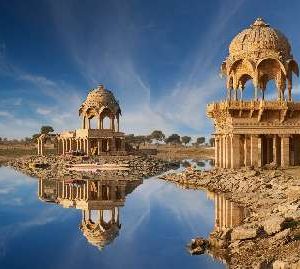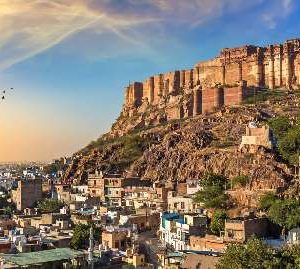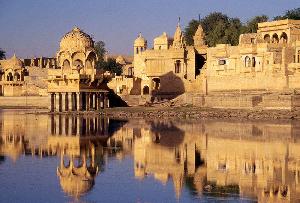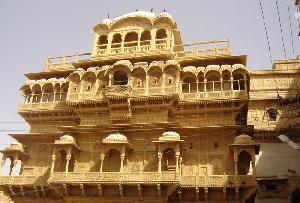Jaisalmer, the Golden City, famous for its majestic fort, intricate havelis, and the golden sands of the Thar Desert. The Jaisalmer Fort, a UNESCO World Heritage site, is one of the city’s major highlights. With 34 years of expertise, Indian Holiday brings you the best-customised tour packages and trusted local support, ensuring a journey as royal as Rajasthan itself.
Still, wondering why Indian Holiday is your best choice? Read this: Your Complete Guide to Stress-Free Group Travel with Indian Holiday How to Plan a Stress-Free Family Vacation with Indian Holiday
Dedicated to the twenty-third Tirthankar, Parsvnath, the Lodurav Jain temple is an absolute splendor of bright yellow sandstones. Though in ruins, one can easily find the pictures of Lord Parsvnath carved all along the temple’s walls.
At the entrance, one can find beautiful arches dominating the whole front portion of the Jain temple. A typical example of the Dilwara style of temple architecture, the Lodurva Temple is a true reminder of the city’s former glory.
Explore 15 Days North India with Nepal Tour Package
Lodurva Temple Complex
The temple complex’s surrounding high wall obscures the temple’s beauty. When you enter, you only get a glimpse of the stunning Parshvanath Temple’s bright yellow exterior. Within the compound, there are additional shrines.
One of this area’s most beautiful architectural features is the Torana at Lodurva. Vandanamalikas, free-standing ornamental or arched gateways, are used in Hindu, Buddhist, and Jain architecture in Southeast Asia, East Asia, and the Indian subcontinent. Toranas are vandamalikas.
Parshwanath Temple at Lodurva
The Parshwanath Jain Temple is Lodurva’s main draw. It is constructed of vivid yellow sandstone, and when we visited around 11 a.m., the temple was bathed in a golden glow that mesmerized us entirely.
The 23rd Jain Tirthankara is Lord Parshvanath. There were also statues of additional Tirthankaras. We were there for about an hour, admiring the magnificent entrance arch, delicate Jaali work, and nearby ruins.
Temple Architecture
This temple building style is unique; it has 8 corners with slanting walls. The walls resemble more of a screen with jaali or latticework made of yellow sandstone. They are constructed to keep the temple’s interior cool. There is good cross ventilation and lighting inside the temple thanks to the holes or net-like structure.
Parshwanath Temple history
The temple was damaged in 1152, but Seth Tharu Shah rebuilt it in 1615. Later, in 1675 and 1687, more expansions were ordered. A black statue of Parshvanath can be found in the temple’s inner sanctum.
A snake represents this temple’s presiding god. Parshvanath Tirthankara is depicted as being covered by a single hood made up of 100 snakes when seated in the Padmasana position. One piece of black Kasauti stone was used to cut the complete statue. On a white marble frame, there are carved human and animal figures all around it. You won’t be able to take your eyes off it due to its aura and mystique.
Browse through our Jaipur Tour Packages from Kolkata, Udaipur Tour Packages from Surat
Interesting Legends inside Lodurva Temple
The temple is mentioned in two intriguing legends—the tour guide who led us around the temple related these tales to us.
One is that a snake lives in the cracks and fissures of the temple’s walls. The inhabitants worship snakes. On the nights, they offer it a bowl of milk; by morning, the bowl is empty. There was a bowl there, as well as a box for cash donations.
Other Shrines in Lodurva Temple Complex
Surrounded by sandy dunes, Lodurva is famous for its historic temples. Besides the very popular Jain temple, one can also visit the Hinglaj Mata Temple, Chamunda Mata Temple, and Shiva Temple.
If you are planning to visit Lodurva Temple, then you must check out our Jaisalmer tour packages.
Check out Rajasthan Tour Packages, Pushkar Tour Packages, Udaipur Tour Packages, Ramkunda Tour Packages, Jodhpur Tour Packages












